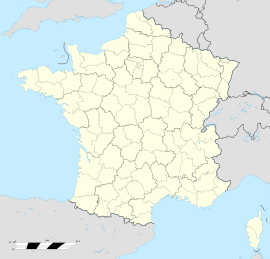- Apt, Vaucluse
-
Apt
Administration Country France Region Provence-Alpes-Côte d'Azur Department Vaucluse Arrondissement Apt Canton Apt Mayor Olivier Curel (PS)
(2008–2014)Statistics Elevation 170–567 m (560–1,860 ft)
(avg. 253 m/830 ft)Land area1 44.57 km2 (17.21 sq mi) Population2 11,158 (2007) - Density 250 /km2 (650 /sq mi) INSEE/Postal code 84003/ 84400 1 French Land Register data, which excludes lakes, ponds, glaciers > 1 km² (0.386 sq mi or 247 acres) and river estuaries. 2 Population without double counting: residents of multiple communes (e.g., students and military personnel) only counted once. Coordinates: 43°52′37″N 5°23′49″E / 43.876945°N 5.396945°E
Apt (Provençal Occitan: At / Ate in both classical and Mistralian norms) is a commune in the Vaucluse department in the Provence-Alpes-Côte d'Azur region in southeastern France.
It lies on the left bank of the Calavon, 41 miles (66 km) east of Avignon. It is the principal town of the Luberon mountains.
Contents
Geography
Apt lies north of Aix-en-Provence and the river Durance, in the valley of the river Calavon, (also called the Coulon), and at the foot of the north-facing slopes of the Luberon mountain.
History
Apt was at one time the chief town of the Vulgientes, a Gallic tribe; it was destroyed by the Romans about 125 BC and restored by Julius Caesar, who conferred upon it the title Apta Julia; it was much injured by the Lombards and the Saracens, but its fortifications were rebuilt by the counts of Provence. The bishopric was founded in the 3rd century. Castor of Apt was bishop of the city during the 5th century. The bishopric was suppressed in 1790.
Important manuscripts were found in Apt concerning music in the 12th/13th Centuries. They are known as the Apt Manuscript and the Ivrea Codex. They contain Motets and Mass Movements, all of which are polyphonic. Nine out of fourteen Motets by Philippe de Vitry are recorded in the Ivrea Codex, a compilation of eighty-one compositions dating to 1360. It is purported to have been derived from the repertoire used in the Papal Palace at Avignon, since it is so close and offers a sampling of music from the Ars Nova movement.
Ecclesiastic history
The council of Apt was held on 14 May 1365 in the cathedral of that city by the archbishops and bishops of the provinces of Arles, Embrun and Aix-en-Provence, in the south of France. Twenty-eight decrees were published and eleven days of indulgence were granted to those who would visit with pious sentiments the church of the Blessed Virgin in the Diocese of Apt on the feast of the Exaltation of the Holy Cross and venerate there certain relics of the Cross.
Sights
The chief object of interest is the church of Sainte-Anne (once the cathedral), the building of which was begun about the year 1056 on the site of a much older edifice, but not completed until the latter half of the 17th century.
The town was formerly surrounded by massive ancient walls, but these have now been for the most part replaced by boulevards; many of its streets are narrow and irregular.
Many Roman remains have been found in and near the town. A fine bridge, the Pont Julien, spanning the Coulon below the town, dates from 2 BC.
Economy
The region is a center for wine, honey, truffles, and fruit, much of which is converted to crystallized fruit by both industrial and handmade processes.
Miscellaneous
A tribunal of first instance and a communal college are the chief public institutions.
See also
References
 This article incorporates text from a publication now in the public domain: Chisholm, Hugh, ed (1911). Encyclopædia Britannica (11th ed.). Cambridge University Press.
This article incorporates text from a publication now in the public domain: Chisholm, Hugh, ed (1911). Encyclopædia Britannica (11th ed.). Cambridge University Press. This article incorporates text from a publication now in the public domain: Herbermann, Charles, ed (1913). Catholic Encyclopedia. Robert Appleton Company.
This article incorporates text from a publication now in the public domain: Herbermann, Charles, ed (1913). Catholic Encyclopedia. Robert Appleton Company.- MANSI, Coll. Conc., XXVI, 445; MARTÈNE, Thes. nov. anecd. (1717), IV, 331-342; BOZE, Hist. de l'église d'Apt (Apt. 1820)
Categories:- Communes of Vaucluse
- Subprefectures in France
Wikimedia Foundation. 2010.



